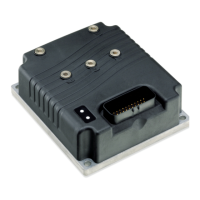Curtis 1222 Manual, os 15
99
2 9 J A N U A R Y 2 0 1 3 D R A F T
7 — DIAGNOSTICS & TROUBLESHOOTING
DIAGNOSTICS & TROUBLESHOOTING
The 1222 controller detects a wide variety of fault conditions. Faults with the
steering controller typically affect the traction controller as well, as shown in
the troubleshooting chart.
DIAGNOSTICS
Diagnostics information can be obtained in either of two ways: (1) by reading
the display on a handheld programmer or (2) by observing the fault codes is
-
sued by the Status LEDs. See Table 4 for a summary of LED display formats.
The handheld programmer will display all faults that are currently set as
well as a history of the faults that have been set since the history log was last
cleared. The programmer displays the faults by name.
The pair of LEDs built into the controller (one red, one yellow) produce
flash codes displaying all the currently set faults in a repeating cycle. Each code
consists of two digits. The red LED flashes once to indicate that the first digit
of the code will follow; the yellow LED then flashes the appropriate number of
times for the first digit. The red LED flashes twice to indicate that the second
digit of the code will follow; the yellow LED flashes the appropriate number
of times for the second digit.
Example: Command Analog3 Out of Range (code 42).
In the Fault menu of the handheld programmer, the words
Command Analog3 Out of Range will be displayed;
the actual voltage is displayed in the Monitor menu
(Command Input
» Analog Input » Analog 3).
The controller’s two LEDs will display this repeating pattern:
RED YELLOW RED YELLOW
✱
✲ ✲ ✲ ✲
✱ ✱
✲ ✲
(first digit)
(4) (second digit) (2)
The numerical codes used by the yellow LED are listed in the troubleshooting
chart (Table 6), which also lists possible fault causes and describes the condi
-
tions that set and clear each fault.
7

